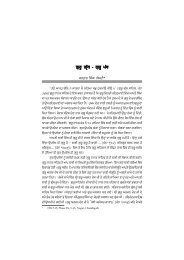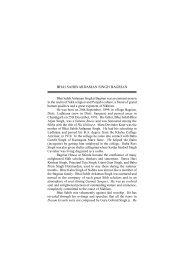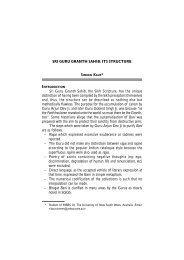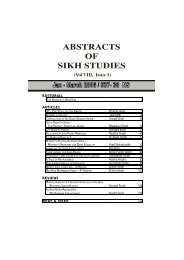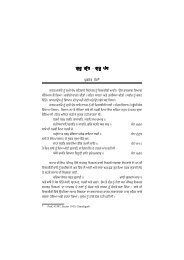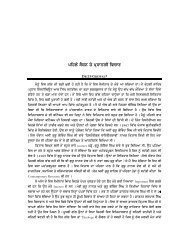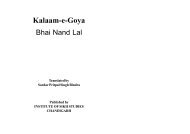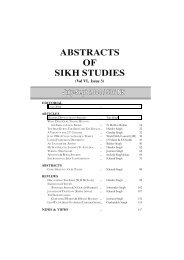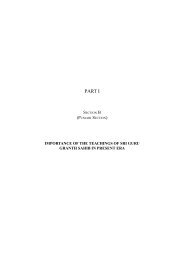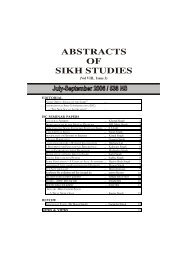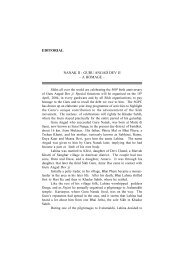editorial articles reviews news & views - Institute of Sikh Studies
editorial articles reviews news & views - Institute of Sikh Studies
editorial articles reviews news & views - Institute of Sikh Studies
You also want an ePaper? Increase the reach of your titles
YUMPU automatically turns print PDFs into web optimized ePapers that Google loves.
96<br />
ABSTRACTS OF SIKH STUDIES : APRIL-JUNE 2005 / 537 NS<br />
detail, they shift the focus <strong>of</strong> their talk to a popular theme to win their<br />
point. No one in this world will deny the significance <strong>of</strong> character.<br />
Both character and appearance have their own separate roles to play<br />
in the life <strong>of</strong> an individual. Emphasis on one does not necessarily<br />
mean abandoning the other.<br />
The learned editor now comes to his point. He starts with a<br />
reference to the WSC held in Sydney in September 2004. I had the<br />
opportunity to attend this conference on its opening day. There were<br />
about 50-60 people present on that day including the organizers,<br />
government <strong>of</strong>ficials and invitees from other religions. I would like to<br />
mention one thing about this conference, before we go further into<br />
the discussion about the <strong>editorial</strong>. S Hardev Singh Shergill said in his<br />
answer to one <strong>of</strong> the questions that in <strong>Sikh</strong>ism there is no place for<br />
priests. But before the start <strong>of</strong> the proceedings for the day, a priest<br />
from a local gurdwara was specially called to perform ardaas or prayer.<br />
And he left immediately after the prayer. The non-<strong>Sikh</strong> attendees<br />
must have gone with the impression that in <strong>Sikh</strong>ism they need a priest<br />
to say their prayer. It would have been better if S Hardev Singh or any<br />
one from the attendees would have come forward to say the prayer. In<br />
short, we are sending conflicting signals to the world. This is the crux<br />
<strong>of</strong> the problem. This is also one <strong>of</strong> the main reasons behind this<br />
confusion about the five ks. We are giving conflicting gestures to our<br />
kids and to the world at large. This <strong>editorial</strong> is doing exactly the same<br />
thing. In <strong>Sikh</strong>ism there is no place for priests, because every <strong>Sikh</strong> is<br />
supposed to be a priest. How many <strong>of</strong> us are ready to perform the<br />
duties <strong>of</strong> a priest, if need be<br />
Coming back to the topic, S Hardev Singh Shergill refers to the<br />
questions about the definition <strong>of</strong> a <strong>Sikh</strong> put to him by some attendees<br />
during this conference. He refers to the definition given in the <strong>Sikh</strong><br />
Rehat Maryada. Astonishingly, he interprets this definition as being<br />
silent about the uncut hair. The definition, as quoted by him, reads<br />
like this: “Any human being who faithfully believes in one immortal<br />
being; the ten Gurus, form Guru Nanak to Guru Gobind Singh; the<br />
Guru Granth Sahib; the utterances and teachings <strong>of</strong> the ten Gurus<br />
and the baptism bequeathed by the tenth Guru, and who does not<br />
owe allegiance to any other religion is a <strong>Sikh</strong>”. What S Hardev Singh<br />
is saying here is that teachings <strong>of</strong> our all the Gurus and the amrit



